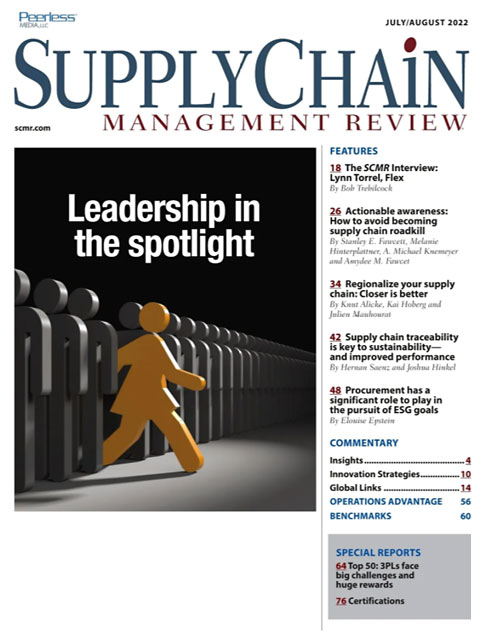Sorry, but your login has failed. Please recheck your login information and resubmit. If your subscription has expired, renew here.
July-August 2022
In late May, I attended the Institute for Supply Management’s first live conference since 2019. The message from Tom Derry, ISM’s CEO, was simple: These are challenging times, but along with the challenges come opportunities for those of us who can step up and lead our organizations into the future. One area where supply chain will be tasked with stepping up to the plate is going to be ESG, the initialism for environmental, social and governance. It was a major theme of the conference, and while all of the reporting requirements are still being debated, there’s little question that supply chain will lead the charge in environmental initiatives… Browse this issue archive.Need Help? Contact customer service 847-559-7581 More options
For the last five years, concepts such as reshoring, nearshoring or China+1 (see sidebar) have been propagating a stronger regionalization of industrial production. Instead of confining global production to Asia, production should take place in (or close to) the market with regional supply chains. The aim for many managers and politicians is resilient local production at low cost with short delivery times and minimum CO2 emissions.
Numerous companies in Europe and North America from very different industries are following this trend: For example, the retail giant Walmart is currently setting up a $350 billion program over the next decade to produce toys, household appliances or textiles in the United States independently of Asian manufacturers. In the semiconductor industry, major players such as Intel, TSMC, Texas Instruments and Samsung have announced investments of $115 billion on fabrication plants in the United States rather than expanding their capacity in Asia. Similarly in Europe, numerous projects around regional battery value chains have been announced, including Northvolt in Sweden, Poland and Germany or ACC in France.
On many levels, these ideas fundamentally contradict the thinking of the past decades, according to which supply chains were essentially planned around the lowest landed cost possible. This cost focus led to a strong concentration of production in Asia in many industries. The resulting supply chains benefited from low wages, material and energy cost advantages, and low transportation costs, while the associated supply networks often span the globe. As a result, complex structures developed with correspondingly long supply chains and long response times, especially for the markets in Europe and North America.
However, events such as the 2011 earthquake in Japan, the COVID-19 pandemic and geopolitical tensions/conflicts have highlighted the limits of these global supply chains. Even small disruptions such as a fire at a supplier somewhere in Asia, a border closure or the brief blocking of the Suez Canal in March 2021 can throw highly complex networks out of sync and can lead to supply problems in other parts of the world. Returning to orderly working networks often takes weeks, if not months. Add to this the increasing focus on CO2-efficient supply chains that also requires reorientation, supporting the trend away from the traditional global export model.

This complete article is available to subscribers only.
Log in now for full access or start your PLUS+ subscription for instant access.
SC
MR
Sorry, but your login has failed. Please recheck your login information and resubmit. If your subscription has expired, renew here.
July-August 2022
In late May, I attended the Institute for Supply Management’s first live conference since 2019. The message from Tom Derry, ISM’s CEO, was simple: These are challenging times, but along with the challenges come… Browse this issue archive. Access your online digital edition. Download a PDF file of the July-August 2022 issue.For the last five years, concepts such as reshoring, nearshoring or China+1 (see sidebar) have been propagating a stronger regionalization of industrial production. Instead of confining global production to Asia, production should take place in (or close to) the market with regional supply chains. The aim for many managers and politicians is resilient local production at low cost with short delivery times and minimum CO2 emissions.
Numerous companies in Europe and North America from very different industries are following this trend: For example, the retail giant Walmart is currently setting up a $350 billion program over the next decade to produce toys, household appliances or textiles in the United States independently of Asian manufacturers. In the semiconductor industry, major players such as Intel, TSMC, Texas Instruments and Samsung have announced investments of $115 billion on fabrication plants in the United States rather than expanding their capacity in Asia. Similarly in Europe, numerous projects around regional battery value chains have been announced, including Northvolt in Sweden, Poland and Germany or ACC in France.
On many levels, these ideas fundamentally contradict the thinking of the past decades, according to which supply chains were essentially planned around the lowest landed cost possible. This cost focus led to a strong concentration of production in Asia in many industries. The resulting supply chains benefited from low wages, material and energy cost advantages, and low transportation costs, while the associated supply networks often span the globe. As a result, complex structures developed with correspondingly long supply chains and long response times, especially for the markets in Europe and North America.
However, events such as the 2011 earthquake in Japan, the COVID-19 pandemic and geopolitical tensions/conflicts have highlighted the limits of these global supply chains. Even small disruptions such as a fire at a supplier somewhere in Asia, a border closure or the brief blocking of the Suez Canal in March 2021 can throw highly complex networks out of sync and can lead to supply problems in other parts of the world. Returning to orderly working networks often takes weeks, if not months. Add to this the increasing focus on CO2-efficient supply chains that also requires reorientation, supporting the trend away from the traditional global export model.
SC
MR


More Global Trade
- Trump picks former Wisconsin congressman Sean Duffy for DOT secretary
- Made in Mexico, manufactured by China
- Retail sales see gains in October, reports Commerce and NRF
- Geopolitical readiness in supply chains: Strategic challenges for leaders
- Tariffs, taxes and trade: The impact of Trump’s reelection on the supply chain
- Aggregators sitting on the throne of Africa’s e-commerce supply chains: What lessons can we learn?
- More Global Trade
Latest Podcast

 Explore
Explore
Procurement & Sourcing News
- Strengthening customer fulfillment: Building a strategic stakeholder network
- Trump picks former Wisconsin congressman Sean Duffy for DOT secretary
- Made in Mexico, manufactured by China
- Retail sales see gains in October, reports Commerce and NRF
- Geopolitical readiness in supply chains: Strategic challenges for leaders
- With capacity to spare, logistics real estate demand remains subdued
- More Procurement & Sourcing
Latest Procurement & Sourcing Resources

Subscribe

Supply Chain Management Review delivers the best industry content.

Editors’ Picks





